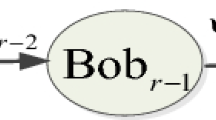Abstract
The purpose of quantum identity authentication is to confirm the identity of participants before the communication. However, there are several flaws in the existing research: (1) The quantum sequence that carry signals needs to be transmitted, and it may be leaked. (2) It generally required the preparation of entangled states to complete authentication, which are not easy to prepare with existing optical technology and could not be fully measured. (3) Only theoretical schemes are proposed without further experimental verification. To overcome the above flaws, a novel quantum identity authentication scheme under the semi-honest third party based on quantum walks on a two-point complete graph is proposed in this paper. The transfer of the particle is easily avoided by generation of the entanglement resources with the conditional shift operator in quantum walks, which reduce the risk of information leakage. The correctness of the proposed scheme is proved by examples and experimental results on the IBM quantum cloud platform. Therefore, the presented scheme has high security and feasibility.



Similar content being viewed by others
Data Availability
The data sets supporting the results of this article are included within the article and its additional files
References
Li, J.K., Zhang, D.Y., Zhang, Y., et al: . Research of User Authentication Mechanism and Its Security Analysis 18, 126–128 (2001)
Li, X.Y., et al.: Study on evolution history and development trend of network trusted identity authentication technology. Cyberspace Security. 9(11), 1 (2018)
Zhu, Q., et al.: Research of the PKI CA authentication technology. Inform. Secur. Technol. 7, 37–39 (2016)
Song, X.R., Zhang, M., et al.: Research on the technology of network trusted identity authentication. Cyberspace Secur. 9, 69–77 (2018)
Hong, C.h., Heo, J., Jang, J.G., et al: Quantum identity authentication with single photon. Quantum Inf. Process. 16, 236 (2017)
Zhang, X.L., Zhao, Y.J., et al.: Two-way synchronous quantum identity authentication protocol based on single photon. J. Comput. Applic. 40 (09), 2634–2638 (2020)
Zhu, H., Wang, L., Zhang, Y., et al.: An efficient quantum identity authentication key agreement protocol without entanglement. Quantum Inf. Process. 19(10), 1–14 (2020)
Jiang, S., Zhou, R.G., Hu, W., et al: Semi-quantum mutual identity authentication using Bell states. Int. J. Theor. Phys. 1–10 (2021)
Li, J.X., He, Z.X., Zhao, S., et al.: Multiparty quantum communication protocol based on quantum stabilizer codes with identity authentication. EPL (Europhysics Letters). 133(2), 20004 (2021)
Zhang, S., Chen, Z.K., Shi, R.H., et al.: A novel quantum identity authentication based on Bell states. Int. J. Theor. Phys. 59(1), 236–249 (2020)
Yin, A., Chen, T., et al.: Authenticated semi-quantum secret sharing based on GHZ-type states. Int. J. Theor. Phys. 60(1), 265–273 (2021)
He, P., Huang, Y., Dai, J., et al.: An improved quantum identity authentication protocol for multi-party secure communication. In: International Conference on Artificial Intelligence and Security, pp. 258–266 (2020)
Li, X.Y., Chang, Y., Zhang, S.B., et al: Quantum secret sharing scheme with credible authentication based on quantum walk. KSII Trans. Internet Inform. Syst. 14(7), 3116–3133 (2020)
Li, X.Y., Chang, Y., Zhang, S.B., et al.: Quantum secret sharing based on quantum walk. Comput. Eng. Des. 41(11), 3030–3035 (2020)
Venegas-Andraca, S.E., et al.: Quantum walks: A comprehensive review. Quantum Inf. Processing. 11(5), 1015–1106 (2012)
Li, H.J., Li, J., Xiang, N., et al.: A new kind of universal and flexible quantum information splitting scheme with multi-coin quantum walks. Quantum Inf. Process. 18, 316 (2019)
Wang, Y., Shang, Y., Xue, P., et al.: Generalized teleportation by quantum walks. Quantum Inf. Process. 16(9), 1–13 (2017)
Xue, P., Zhang, R., Qin, H., et al: Experimental quantum-walk revival with a time-dependent coin. Phys. Rev. Lett. 114(14), 140502 (2015)
Zhou, W.D., et al: Review on quantum walk algorithm. J. Phys.: Conf. Ser. 1748(3), 032022 (2021)
Aharonov, Y., Davidovich, L., Zagury, N., et al.: Quantum random walks. Phys. Rev. A. 48(2), 1687 (1993)
Salimi, S., et al.: Continuous-time quantum walks on semi-regular spidernet graphs via quantum probability theory. Quantum Inf. Process. 9, 75–91 (2010)
Shang, Y., Wang, Y., Li, M., et al.: Quantum communication protocols by quantum walks with two coins. EPL (Europhysics Letters). 124(6), 60009 (2019)
Ambainis, A., Bach, E., Nayak, A., et al.: One-dimensional quantum walks. In: Proceedings of the Thirty-Third Annual ACM Symposium on Theory of Computing, pp. 37–49 (2001)
Aharonov, D., Ambainis, A., Kempe, J., et al.: Quantum walks on graphs. In: Proceedings of the Thirty-Third Annual ACM Symposium on Theory of Computing, pp 50–59 (2001)
Di Franco, C., Mc Gettrick, M., Busch, T., et al: Mimicking the probability distribution of a two-dimensional Grover walk with a single-qubit coin. Phys. Rev. Lett. 106(8), 080502 (2011)
Bennett, C.H., Brassard, G., et al.: Quantum cryptography: Public key distribution and coin tossing. In: Proceedings of IEEE International Conference on Computers: Systems and Signal Processing, pp. 175–179 (1984)
Shor, P.W., Preskill, J., et al.: Simple proof of security of the BB84 quantum key distribution protocol. Phys. Rev. Lett. 85(2), 441–444 (2000)
Zhang, X., et al.: Research on Quantum Secure Multi-party Computation. Heilongjiang University (2019)
Sun, M.H., et al.: Research on secure multiparty computing and its application. Beijing University of Posts and Telecommunications (2013)
Wu, W., Zhao, Y., et al.: Quantum private comparison of size using d-level Bell states with a semi-honest third party. Quantum Inf. Process. 20, 155 (2021)
Funding
Project supported by Natural Science Foundation of Hunan Province (2021JJ30454), Hunan Provincial Science and Technology Project Foundation (2018TP1018).
Author information
Authors and Affiliations
Corresponding author
Additional information
Publisher’s Note
Springer Nature remains neutral with regard to jurisdictional claims in published maps and institutional affiliations.
Rights and permissions
About this article
Cite this article
Lou, X., Wang, S., Ren, S. et al. Quantum Identity Authentication Scheme Based on Quantum Walks on Graphs with IBM Quantum Cloud Platform. Int J Theor Phys 61, 40 (2022). https://doi.org/10.1007/s10773-022-04986-2
Received:
Accepted:
Published:
DOI: https://doi.org/10.1007/s10773-022-04986-2




